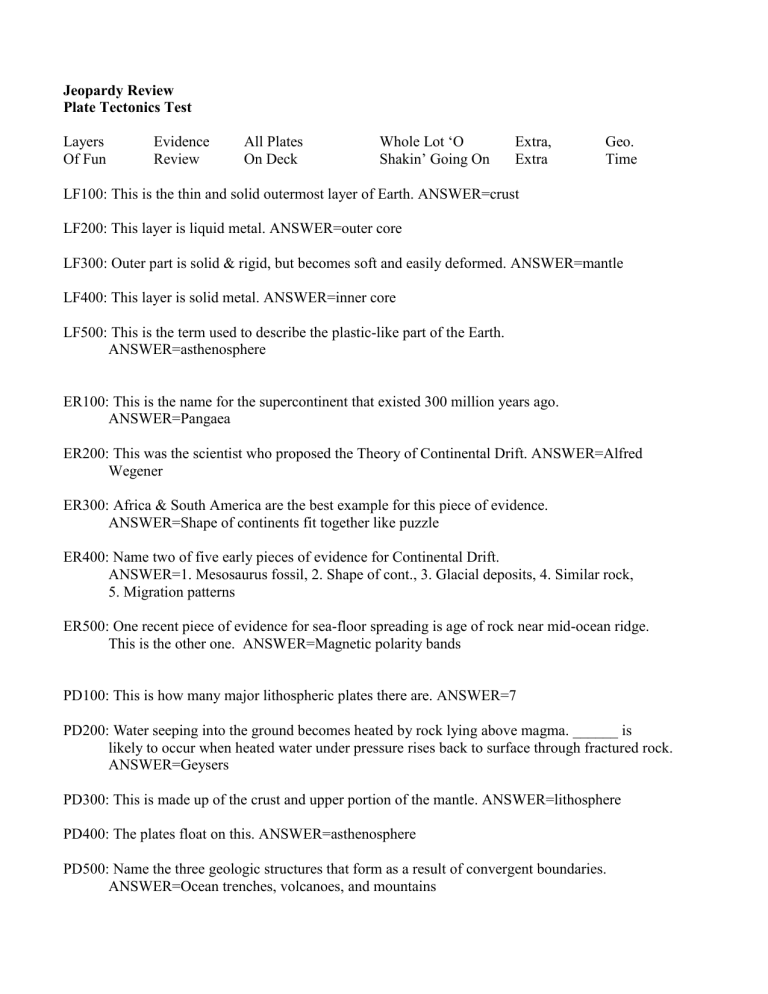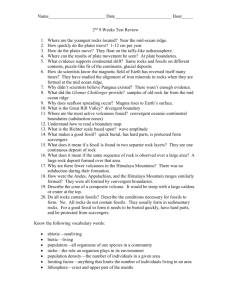Jeopardy Review - Solon City Schools

Jeopardy Review
Plate Tectonics Test
Layers
Of Fun
Evidence
Review
All Plates
On Deck
Whole Lot ‘O
Extra,
Shakin’ Going On
Extra
LF100: This is the thin and solid outermost layer of Earth. ANSWER=crust
Geo.
Time
LF200: This layer is liquid metal. ANSWER=outer core
LF300: Outer part is solid & rigid, but becomes soft and easily deformed. ANSWER=mantle
LF400: This layer is solid metal. ANSWER=inner core
LF500: This is the term used to describe the plastic-like part of the Earth.
ANSWER=asthenosphere
ER100: This is the name for the supercontinent that existed 300 million years ago.
ANSWER=Pangaea
ER200: This was the scientist who proposed the Theory of Continental Drift. ANSWER=Alfred
Wegener
ER300: Africa & South America are the best example for this piece of evidence.
ANSWER=Shape of continents fit together like puzzle
ER400: Name two of five early pieces of evidence for Continental Drift.
ANSWER=1. Mesosaurus fossil, 2. Shape of cont., 3. Glacial deposits, 4. Similar rock,
5. Migration patterns
ER500: One recent piece of evidence for sea-floor spreading is age of rock near mid-ocean ridge.
This is the other one. ANSWER=Magnetic polarity bands
PD100: This is how many major lithospheric plates there are. ANSWER=7
PD200: Water seeping into the ground becomes heated by rock lying above magma. ______ is likely to occur when heated water under pressure rises back to surface through fractured rock.
ANSWER=Geysers
PD300: This is made up of the crust and upper portion of the mantle. ANSWER=lithosphere
PD400: The plates float on this. ANSWER=asthenosphere
PD500: Name the three geologic structures that form as a result of convergent boundaries.
ANSWER=Ocean trenches, volcanoes, and mountains
SG100: The machine that measures the movements of an earthquake. ANSWER=seismograph
SG200: The Richter scales measures the ___ of an earthquake. ANSWER=magnitude
SG300: These waves arrive second at a recording station. ANSWER=s-waves
SG400: These waves can only travel through solids. ANSWER=surface waves
SG500: P-waves are also known as this. ANSWER=longitudinal waves
EE100: This is the exact point where an earthquake originates. ANSWER=Focus
EE200: At this boundary, seismic waves accelerate due to density differences. ANSWER=Moho
Boundary
EE300: These are the two ways that thermal energy is transferred through Earth.
ANSWER=conduction and convection
EE400: When 2 lithospheric plates move apart, it is called this type of boundary.
ANSWER=divergent
EE500: Name 4 of the 8 minor lithospheric plates. ANSWER=Nazca, Scotia, Caribbean, Cocos,
Juan de Fuco, Filipino, Indian, Arabian
GT100: This is why fossils are good indicators of relative age. ANSWER=They occur for a well- defined period of time.
GT200: This is the process scientists use to determine absolute age. ANSWER=radioactive dating
GT300: This is the principle that says rock layers are laid down horizontally.
ANSWER=Original horizontality
GT400: Rocks that are on the bottom of the sequence are ______ than the rocks on the top of the sequence. ANSWER=older
GT500: Which layers is older A or B? Why? ANSWER=B, because of inclusion
Water seeping into ground becomes heated by rock lying above magma. When heated water under pressure rises back to the surface, a geyser is formed.
Final Jeopardy: Scientists have been able to date rocks on Earth at 3.8 billion years old, yet the age of Earth is 4.6 billion. How do we know this? Moon rocks are older and meteorites are older











